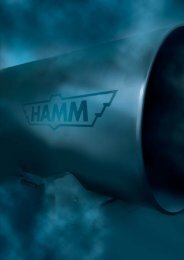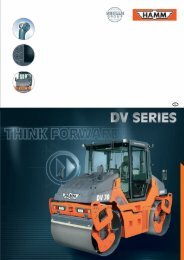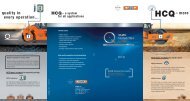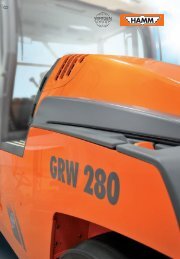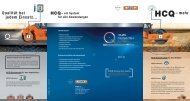Flyer Oscillation - Hamm AG
Flyer Oscillation - Hamm AG
Flyer Oscillation - Hamm AG
Create successful ePaper yourself
Turn your PDF publications into a flip-book with our unique Google optimized e-Paper software.
More than 25 years of success<br />
and experience with <strong>Oscillation</strong>!<br />
Vibration –<br />
<strong>Oscillation</strong>:<br />
100%<br />
95%<br />
90%<br />
85%<br />
Benefits of <strong>Oscillation</strong><br />
cp–2.com<br />
O S C I L L A T I O N<br />
Vibration<br />
A rotating eccentric mass provides<br />
fast up-and-down movement of the<br />
roller drum.<br />
<strong>Oscillation</strong><br />
Two eccentric masses rotate in sync.<br />
This produces a rapidly changing<br />
forward/reverse, rocking movement<br />
of the roller drum.<br />
• The ultimate in compaction performance<br />
• You cannot over-compact – no grain crushing<br />
• No chatter marks for perfect smoothness<br />
• No vibration to sensitive surroundings or the machine<br />
• No damage to cold joints<br />
• Able to work effectively and safely on cooler mixes<br />
• Fewer passes required<br />
• Uniform density<br />
• Self adjusting<br />
<strong>Oscillation</strong> is the most<br />
intelligent compactor!<br />
© HAMM - 08.11 - 2200179 E<br />
<strong>Oscillation</strong>:<br />
The proven technology!<br />
Thousands of <strong>Oscillation</strong> compactors<br />
in use around the globe.<br />
HAMM <strong>AG</strong><br />
<strong>Hamm</strong>strasse 1<br />
D-95643 Tirschenreuth<br />
Tel +49 9631/ 80-0<br />
Fax +49 9631/ 80-111<br />
www.hamm.eu<br />
The compaction technology of the future<br />
Proven successful for decades<br />
Vibration<br />
The compaction energy is introduced vertically in the downward<br />
direction. Due to the up-and-down movement, the roller drum<br />
loses contact with the ground after each impact. For approximately<br />
50% of the time, it is not in contact with the ground.<br />
<strong>Oscillation</strong><br />
The compaction energy is introduced both vertically and horizontally<br />
to the front and rear of the drum. During the rocking<br />
movement, the roller drum does not lift off of the ground. On the<br />
contrary: It maintains continuous contact with material so that<br />
constant compaction occurs.
Faster compaction results<br />
Self adjusting compaction power<br />
More time for compaction<br />
Masters even the biggest challenges<br />
<strong>Oscillation</strong> makes it possible to achieve a faster increase in compaction.<br />
Why? During the forward and rearward movements of the drum, the<br />
compaction force is directed into the material, with the maximum<br />
utilization of the available compaction window.<br />
Advantages<br />
• Fewer passes needed compared to vibration<br />
• Faster increase in compaction<br />
The principle of <strong>Oscillation</strong> involves intelligent exploitation of the laws<br />
of physics. Depending on the rigidity of the material, the movement<br />
of the oscillating drum changes automatically: The more rigid the<br />
material, the less the movement. The system adapts automatically to<br />
the conditions without any presettings or preselection of the vibratory<br />
system.<br />
Advantages<br />
• Optimum compaction power at all times<br />
• No presettings No faulty settings<br />
Compaction work is possible only within a specifi c temperature<br />
range in relation to the asphalt type. To avoid displacing the material,<br />
vibrating rollers do not begin compaction until the right asphalt<br />
temperature is reached. In contrast, <strong>Oscillation</strong> rollers can begin<br />
effi cient dynamic compaction at high temperatures. As the asphalt<br />
begins to cool, vibration can result in grain crushing or destruction of<br />
the granular structure. On the other hand, <strong>Oscillation</strong> continuous to<br />
compact even at lower temperatures, without damage to the material.<br />
Advantages<br />
• With <strong>Oscillation</strong>, time frame for compaction is enlarged<br />
• More fl exibility<br />
• Excellent results in lower temperatures and/or windy conditions<br />
<strong>Oscillation</strong> rollers are your trump card when you need to compact thin<br />
layers or hard-to-handle materials, or when working on vibrationsensitive<br />
structures. In all of these cases, these rollers provide high<br />
compaction power combined with effi cient, dynamic compaction.<br />
When paving asphalt on bridges or installing thin layers, the asphalt<br />
cools off more quickly. Using the oscillation technique, this is not a<br />
problem since the rollers still deliver effi cient compaction at lower<br />
asphalt temperatures.<br />
<strong>Oscillation</strong> rollers can also be used to perform high-quality<br />
compaction of hard-to-handle modern mixes such as stone mastic<br />
asphalt.<br />
160° C / 320° F 140° C / 284° F 120° C / 248° F 100° C / 212° F 80° C / 176° F 60° C / 140° F<br />
VIBRATION<br />
C°/F<br />
Advantages<br />
• Also suitable for hard-to-compact types of asphalt<br />
• Ideal for dynamic compaction of thin-layer asphalts<br />
• Ideal for dynamic compaction on/or near sensitive structures<br />
Static<br />
OSCILLATION<br />
Static<br />
enlarged<br />
time frame with<br />
<strong>Oscillation</strong><br />
SOFT MATERIAL<br />
RIGID MATERIAL<br />
Continuous ground contact<br />
No over-compaction and<br />
no grain crushing<br />
Excellent compaction on joints<br />
Perfect smoothness<br />
Another benefi t: Compared to the vibration technique, only about<br />
15% of the vibratory affect is directed into the surrounding environment.<br />
This means that effi cient dynamic <strong>Oscillation</strong> compaction can<br />
easily be performed even in the vicinity of sensitive buildings or structures<br />
like bridges.<br />
In vibratory compaction, there is a risk of destroying the granular<br />
structure or grain crushing after a certain point is reached. However,<br />
this is not the case with <strong>Oscillation</strong>. The rigidity increases after each<br />
pass – without any undesired side-effects.<br />
At the joint between two driving lanes, e.g. when one lane is repaved,<br />
<strong>Oscillation</strong> avoids damage to the other lane, that is already fi nished,<br />
compacted and cooled down. Transverse passes are also no problem.<br />
The existing, cold road surface is not damaged or destroyed.<br />
Another result of <strong>Oscillation</strong> is a perfectly smooth surface fi nish.<br />
Due to the absence of any vertical impacts on<br />
the material, no bumps are formed.<br />
This means that roadways compacted with<br />
<strong>Oscillation</strong> result in a perfectly smooth fi nish.<br />
Advantages<br />
• Continuous dynamic compaction<br />
• Little vibratory affect of surroundings<br />
• Dynamic compaction even in sensitive areas and bridges<br />
• Ideal for dynamic compaction on bridges<br />
• Ideal for dynamic compaction over gas and water lines,<br />
near railroad tracks, etc.<br />
OSCILLATION<br />
VIBRATION<br />
Advantages<br />
• High degree of compaction<br />
• No over-compaction<br />
• Intact granular structure<br />
• No grain crushing<br />
• Achieving optimal density levels<br />
Advantages<br />
• Optimal, dynamic compaction<br />
all the way to the joint<br />
• No destruction of cold road surface<br />
• Long-lasting joint<br />
Advantages<br />
• Excellent ride ability<br />
• No chatter marks<br />
HOT<br />
COLD




